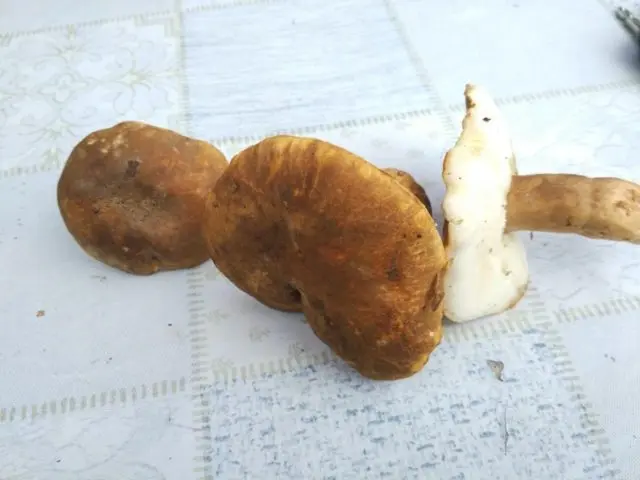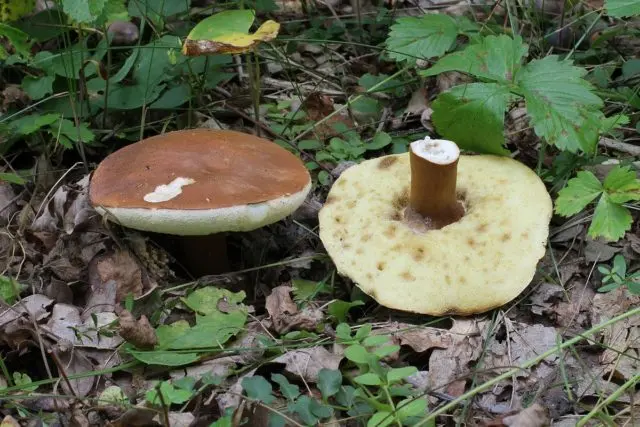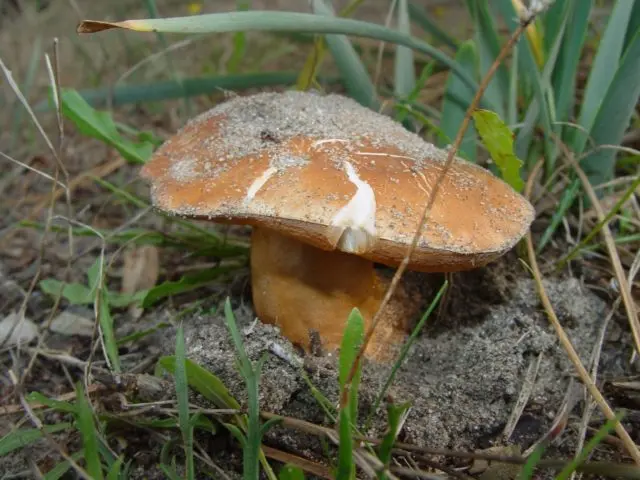Contents
Gyroporus sandy is a representative of the Gyroporaceae family, the genus Gyroporus. Synonyms of this name are Latin terms – Gyroporus castaneus var. Amophilus and Gyroporus castaneus var. Ammophilus.
What does gyroporus sandy look like

Inedible and poisonous
In a young sandy gyroporus, the cap is convex or hemispherical in shape, after a while it becomes prostrate with raised edges. Its size in diameter varies from 4 to 15 cm. The surface is dry, smooth, matte, in some specimens you can notice small hairiness. Initially, the cap of sandy gyroporus is pinkish or ocher in color, gradually acquiring yellow-brown hues with pinkish zones. In this case, the edges are always lighter than the central part of the cap. The tubular hymenophore is pinkish or cream in color, does not change its color upon contact. The tubules are short and thin, free from caps. The pores are monochromatic, quite small at the initial stage of maturation, but become wide with age.
The leg of the sandy gyroporus is cylindrical, widened at the base. In young gifts, the forest is painted white, as it grows older it acquires a shade similar to a hat. The surface is smooth. The structure is spongy with cavities (chambers), and on the outside it is covered with a hard crust.
The pulp of the sandy gyroporus is quite fragile, becoming spongy in old specimens. It is salmon-pink in color, but in adulthood it can acquire bluish hues. It has a sweetish taste and an unexpressed smell.
Where does Gyroporus sandy grow?
Most often, the species in question is found in the autumn season in coastal areas, coniferous forests or dunes. When settling, sandy gyroporus prefers limestone soils. Can grow singly or in small groups. Most common in Europe.
Twins of Gyroporus sandy
According to external signs, the considered gift of the forest is very similar to chestnut gyroporus.

Gyroporus chestnut is a conditionally edible mushroom.
Distinctive features of the twin are a rusty or red-brown color of the cap, as well as a tubular yellowish hymenophore.
Is it possible to eat sandy gyroporus
This specimen belongs to the category of inedible mushrooms. In addition, sandy gyroporus contains toxic substances.
Symptoms of poisoning

The use of this mushroom in food leads to a long-term disorder of the gastrointestinal tract.
Quite often it happens that, through negligence or ignorance, a person can eat a poisonous mushroom. In this case, a couple of hours after eating sandy gyroporus, the victim feels the first symptoms of poisoning:
- nausea;
- diarrhea;
- stomach ache;
- vomiting.
The duration of unpleasant consequences depends on the amount of mushrooms eaten, human body weight and individual characteristics. Thus, the average period of negative symptoms lasts about 6-7 hours, but under certain circumstances it can last for several weeks.
First aid for poisoning
In case of poisoning with sandy gyroporus, the victim must immediately provide first aid:
- First of all, you should rinse the stomach to cleanse it of toxins. To do this, give 1 liter of salted water to drink and induce vomiting. This procedure should be repeated at least 2 times.
- If the victim does not have diarrhea, then he can be offered 1 tablespoon of vaseline or castor oil.
- You can clean the intestines from harmful substances using any sorbent. For example, give the patient activated charcoal and polysorb.
- After all the above actions, the victim must organize bed rest and provide plenty of fluids. Normal or mineral non-carbonated water, as well as strong black tea, will do.
Conclusion
Outwardly, sandy gyroporus looks no worse than edible mushrooms. However, you should know that this specimen is poisonous and it is extremely forbidden to use it for food. But if this still happened, you should not self-medicate. Therefore, when the first symptoms occur, it is recommended to urgently call an ambulance or take the patient to a medical institution on their own.









